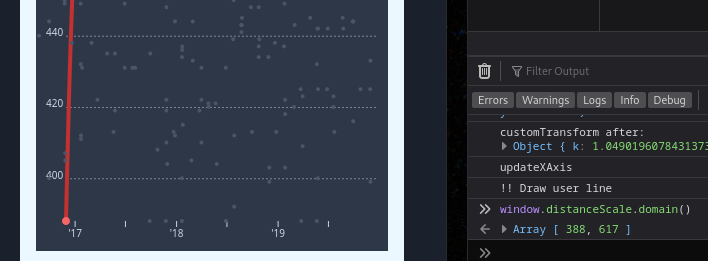d3.slider = function module() {
"use strict";
var div, min = 0, max = 100, svg, svgGroup, value, classPrefix, axis,
height=40, rect,
rectHeight = 12,
tickSize = 6,
margin = {top: 25, right: 25, bottom: 15, left: 25},
ticks = 0, tickValues, scale, tickFormat, dragger, width,
range = false,
callbackFn, stepValues, focus;
function slider(selection) {
selection.each(function() {
div = d3.select(this).classed('d3slider', true);
width = parseInt(div.style("width"), 10)-(margin.left
+ margin.right);
value = value || min;
scale = d3.scaleLinear().domain([min, max]).range([0, width])
.clamp(true);
// SVG
svg = div.append("svg")
.attr("class", "d3slider-axis")
.attr("width", width + margin.left + margin.right)
.attr("height", height + margin.top + margin.bottom)
.append("g")
.attr("transform", "translate(" + margin.left +
"," + margin.top + ")");
// Range rect
svg.append("rect")
.attr("class", "d3slider-rect-range")
.attr("width", width)
.attr("height", rectHeight);
// Range rect
if (range) {
svg.append("rect")
.attr("class", "d3slider-rect-value")
.attr("width", scale(value))
.attr("height", rectHeight);
}
// Axis
var axis = d3.axisBottom()
.scale(scale);
if (ticks != 0) {
axis.ticks(ticks);
axis.tickSize(tickSize);
} else if (tickValues) {
axis.tickValues(tickValues);
axis.tickSize(tickSize);
} else {
axis.ticks(0);
axis.tickSize(0);
}
if (tickFormat) {
axis.tickFormat(tickFormat);
}
svg.append("g")
.attr("transform", "translate(0," + rectHeight + ")")
.call(axis)
//.selectAll(".tick")
//.data(tickValues, function(d) { return d; })
//.exit()
//.classed("minor", true);
var values = [value];
dragger = svg.selectAll(".dragger")
.data(values)
.enter()
.append("g")
.attr("class", "dragger")
.attr("transform", function(d) {
return "translate(" + scale(d) + ")";
})
var displayValue = null;
if (tickFormat) {
displayValue = tickFormat(value);
} else {
displayValue = d3.format(",.0f")(value);
}
dragger.append("text")
.attr("x", 0)
.attr("y", -15)
.attr("text-anchor", "middle")
.attr("class", "draggertext")
.text(displayValue);
dragger.append("circle")
.attr("class", "dragger-outer")
.attr("r", 10)
.attr("transform", function(d) {
return "translate(0,6)";
});
dragger.append("circle")
.attr("class", "dragger-inner")
.attr("r", 4)
.attr("transform", function(d) {
return "translate(0,6)";
});
// Enable dragger drag
var dragBehaviour = d3.drag();
dragBehaviour.on("drag", slider.drag);
dragger.call(dragBehaviour);
// Move dragger on click
svg.on("click", slider.click);
});
}
slider.draggerTranslateFn = function() {
return function(d) {
return "translate(" + scale(d) + ")";
}
}
slider.click = function() {
var pos = d3.event.offsetX || d3.event.layerX;
slider.move(pos);
}
slider.drag = function() {
var pos = d3.event.x;
slider.move(pos+margin.left);
}
slider.move = function(pos) {
var l,u;
var newValue = scale.invert(pos - margin.left);
// find tick values that are closest to newValue
// lower bound
if (stepValues != undefined) {
l = stepValues.reduce(function(p, c, i, arr){
if (c < newValue) {
return c;
} else {
return p;
}
});
// upper bound
if (stepValues.indexOf(l) < stepValues.length-1) {
u = stepValues[stepValues.indexOf(l) + 1];
} else {
u = l;
}
// set values
var oldValue = value;
value = ((newValue-l) <= (u-newValue)) ? l : u;
} else {
var oldValue = value;
value = newValue;
}
var values = [value];
// Move dragger
svg.selectAll(".dragger").data(values)
.attr("transform", function(d) {
return "translate(" + scale(d) + ")";
});
var displayValue = null;
if (tickFormat) {
displayValue = tickFormat(value);
} else {
displayValue = d3.format(",.0f")(value);
}
svg.selectAll(".dragger").select("text")
.text(displayValue);
if (range) {
svg.selectAll(".d3slider-rect-value")
.attr("width", scale(value));
}
if (callbackFn) {
callbackFn(slider);
}
}
// Getter/setter functions
slider.min = function(_) {
if (!arguments.length) return min;
min = _;
return slider;
};
slider.max = function(_) {
if (!arguments.length) return max;
max = _;
return slider;
};
slider.classPrefix = function(_) {
if (!arguments.length) return classPrefix;
classPrefix = _;
return slider;
}
slider.tickValues = function(_) {
if (!arguments.length) return tickValues;
tickValues = _;
return slider;
}
slider.ticks = function(_) {
if (!arguments.length) return ticks;
ticks = _;
return slider;
}
slider.stepValues = function(_) {
if (!arguments.length) return stepValues;
stepValues = _;
return slider;
}
slider.tickFormat = function(_) {
if (!arguments.length) return tickFormat;
tickFormat = _;
return slider;
}
slider.value = function(_) {
if (!arguments.length) return value;
value = _;
return slider;
}
slider.showRange = function(_) {
if (!arguments.length) return range;
range = _;
return slider;
}
slider.callback = function(_) {
if (!arguments.length) return callbackFn;
callbackFn = _;
return slider;
}
slider.setValue = function(newValue) {
var pos = scale(newValue) + margin.left;
slider.move(pos);
}
slider.mousemove = function() {
var pos = d3.mouse(this)[0];
var val = slider.getNearest(scale.invert(pos), stepValues);
focus.attr("transform", "translate(" + scale(val) + ",0)");
focus.selectAll("text").text(val);
}
slider.getNearest = function(val, arr) {
var l = arr.reduce(function(p, c, i, a){
if (c < val) {
return c;
} else {
return p;
}
});
var u = arr[arr.indexOf(l)+1];
var nearest = ((value-l) <= (u-value)) ? l : u;
return nearest;
}
slider.destroy = function() {
div.selectAll('svg').remove();
return slider;
}
return slider;
};





